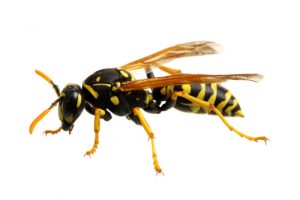Wasps Indoors in Winter! What Gives?
By Chris Williams on March 8, 2011.
Q. I found a wasp in an upstairs bedroom yesterday, flying around indoors in the middle of winter! It was mostly black with some yellow stripes and long legs. I thought it was a one time thing but today I found another one in a bathroom window. What’s going on? Do they have a nest inside?
A. No nest, you just have some temporary winter guests. At least you’re entertaining royalty! These are no doubt future paper wasp queens. Other wasps sometimes spend the winter indoors, but paper wasps are notorious for ending up inside. They’re the wasps that make those open-comb nests outside that look like an upside-down umbrella. In fact, they’re sometimes called umbrella wasps.
 In late summer or early fall, the paper wasps in a nest begin to die except for newly mated females who are destined to be next year’s queens. When the weather cools, their internal clock tells these future queens that it’s time to find a protected place to wait out the winter. Usually that’s outside under bark, or logs, or even under siding or shingles. But if they can find an opening into a nice, warm attic, they’ll take it!
In late summer or early fall, the paper wasps in a nest begin to die except for newly mated females who are destined to be next year’s queens. When the weather cools, their internal clock tells these future queens that it’s time to find a protected place to wait out the winter. Usually that’s outside under bark, or logs, or even under siding or shingles. But if they can find an opening into a nice, warm attic, they’ll take it!
Most people don’t even notice the gradual migration of the wasps inside (although sometimes you see them hanging around outside looking longingly at your doors and windows!). Because paper wasps fly, they are able to enter through openings near the roof line and often end up in attics. They also hide in wall voids, behind baseboards, behind draperies, under carpet edges, and in various cracks and crevices.
Paper wasps don’t move around much once they’ve settled in and you usually won’t even know they’re there – until the first warm days of spring or (as you’ve discovered!), sometimes during a warm spell in the winter. Then the wasps become active again and start looking for a way to get back outside. They’re attracted to light at windows. They are usually sluggish as they crawl and fly about inside and can be easily caught, or squashed, or vacuumed. They’re not aggressive but remember that they are still capable of stinging if handled!
If you have a large population of overwintering wasps in an attic or in wall or ceiling voids, you may need to have a professional treat those areas. Next year, consider an outside preventive treatment in early fall to help keep them from moving in. Also caulk or seal openings around roof eaves, utility line entrances, or other sites where wasps may be entering your home.
For more on paper wasps, look under Bees and Wasps in our website’s Pest Library.
Sign up for our biweekly email newsletter for more information about bugs and pests!